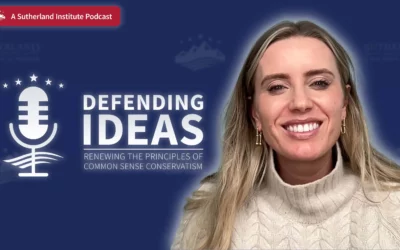
Written by Christine Cooke Fairbanks
March 4, 2021
This is part 15 in Sutherland’s new series that seeks to examine how Utah education standards prepare students to be active citizens. In this part, we analyze current social studies standards for grades 7-12. While there are a range of social studies courses in grades 7-12, this review looks at all the social studies courses in grades 7-12, except for the required one-semester “civics course” titled United States Government and Citizenship, which was analyzed separately.
The Equality Act – a bill that would extend LGBTQ people the same nondiscrimination protections of the Civil Rights Act of 1964 – recently passed the United States House of Representatives. Now it is on to the Senate (for the second time). If it passes, the bill is awaited by a president who would certainly sign the bill into law.
In short, equality remains a hot-button issue in America today. Students are hearing about and navigating the topic of equality now more than ever before.
Are they equipped? The public school system is constantly updating its standards with the hope of helping students do just that.
The Utah State Board of Education is currently in the standards revision process for the Utah State Social Studies standards only for elementary school grades (kindergarten through sixth grade), but we think it is helpful to review our state approach to civics education at all levels of education. Sutherland Institute is seeking to understand how well Utah’s current social studies standards help students fulfill their duties in civil society and government. For this review, we are specifically looking at equality before the law.
To help assess how well the current standards help students fulfill their duties in civil society and government with regard to equality before the law, we have decided to look for two main factors: (1) mentions of the Declaration of Independence or of the amendments to the Constitution by name (13-15 and 19) and (2) discussion of the substance in the Declaration of Independence or these amendments (i.e., the end of slavery, equal protection before the law, right to vote regardless of race or gender).
Social Studies in grades 7-12 (except for U.S. Government & Citizenship course)
Mentions of the Declaration of Independence or amendments to the Constitution by name (13-15 and 19)
The standards for all 7-12 social studies courses (U.S. Government & Citizenship excluded) do not directly reference the Declaration of Independence or any of the amendments listed above (13th, 14th, 15th, or 19th).
Discussion of the substance in the Declaration of Independence or these amendments (i.e., the end of slavery, equal protection before the law, right to vote regardless of race or gender)
Many of the standards for social studies courses may indirectly lead educators to teach the substance or ideas found in the Declaration of Independence or the amendments named above. For example, one strand focuses on the American Revolution and includes two different standards, including identifying the ideas used to justify the Revolution or how the ideas of the Revolution continue to shape American identity, which means students may discuss the concepts of equality found in the Declaration of Independence.
Another standard asks students to explain why the rights, liberties and responsibilities of citizens have changed over time, which would likely lead to a discussion about different groups of people (like African Americans or women) who have struggled for and later obtained rights that lead to political and legal equality. In a similar way, other standards prompt students to document the expansion of rights over time and to identify conditions that led to reform movements, including the “women’s rights movement” and “the Abolitionist movement.”
Standards in the United States History 2 course are the most likely to directly address these topics since they ask students to discuss reform movements like suffrage and/or how reform movements led to specific amendments to the Constitution. Together these suggest a discussion about the 19th amendment. Another strand on Traditions and Social Change prompt something similar, asking students to discuss reforms that came out of the civil rights movement.
Not surprisingly, the strand on the Civil War and Reconstruction Era is bound to prompt a discussion about the end of slavery and the aftermath. Standards discuss slavery as well as the “implications of the Civil War.” Such implications could be the amendments that came later to secure freedom and voting rights for those who had been or were descendants of slaves.
Even World Geography to some extent discusses equality. For example, one discusses the relationship between economic development and “gender equality,” which is an extension of discussion about equal rights for women enshrined in securing the right to vote regardless of gender or race.
Conclusion
In short, standards for Utah’s Social Studies courses in grades 7-12 are very likely to discuss the concept of equality. Standards either directly or indirectly prompt a discussion about equality all throughout the courses. However, the standards are less likely to directly reference amendments from the U.S. Constitution that enshrine these protections. It’s clear that the theme of equality is adequately addressed, though more direct references to the codification of this American principle could be increased.
(Note: What’s a “standard”? It is a broad statement of what students are expected to understand and/or know how to do within a certain discipline.
What’s an “objective”? An objective is a more focused description of what students need to know and/or be able to do within a given standard.
What’s an “indicator”? These are measurable and observable student actions that enable teachers to judge whether a student has mastered a particular objective.)
Jump to different parts of this series:
- Teaching freedom of speech and a pluralistic society in grades K-6
- Teaching freedom of religion in grades K-6
- Teaching freedom of the press and media literacy in grades K-6
- Teaching ‘equality before the law’ in grades K-6
- Teaching checks and balances in grades K-6
- Hey parents – want to get involved in the standards revision process?
- Teaching freedom of speech in grades 7-12
- Teaching freedom of religion in grades 7-12
- Teaching freedom of the press in grades 7-12
- Teaching equality before the law in grades 7-12
- Cancel culture points to big question: Are students learning about freedom of speech?
- ‘Public schools are not religion-free zones’
- Do education standards help students’ media literacy?

Utah Core Standards, Objectives and Indicators referenced:
Source: Utah Core Standards, Utah State Board of Education
U.S. 1 Standard 3.1
Students will use primary sources to identify the significant events, ideas, people, and methods used to justify or resist the Revolutionary movement.
U.S. 1 Standard 3.4
Students will explain how the ideas and events of the American Revolution continue to shape American identity.
U.S. 1 Standard 4.3
Students will use historic case studies and current events to trace how and explain why the rights, liberties, and responsibilities of citizens have changed over time.
U.S. 1 Standard 5.2
Students will identify the conditions that gave rise to, and evaluate the impact of, social and political reform movements such as Jacksonian Democracy, the women’s rights movement, the Abolitionist movement, and anti-immigration reform.
U.S. 1 Standard 5.3
Students will use case studies to document the expansion of democratic principles and rights over time.
U.S. 1 Standard 7.1
Students will explain how slavery and other geographic, social, economic, and political differences between the North, South, and West led to the Civil War.
U.S. 1 Standard 7.4
Students will use current events to evaluate the implications of the Civil War and Reconstruction for contemporary American life.
WG Standard 5.5
Students will describe the costs, benefits, and sustainability of development in terms of poverty rates, standards of living, the impact on indigenous people, environmental changes, gender equality, and access to education.
U.S. 2 Standard 2.1
Students will use primary and secondary sources to identify and explain the conditions that led to the rise of reform movements, such as organized labor, suffrage, and temperance.
U.S. 2 Standard 2.2
Students will explain how social reform movements influenced Constitutional amendments and changes to laws and democratic processes.
U.S. 2 Standard 4.2
Students will use case studies involving African-American civil rights leaders and events to compare, contrast, and evaluate the effectiveness of various methods used to achieve reform, such as civil disobedience, legal strategies, and political organizing.
U.S. 2 Standard 4.3
Students will identify the civil rights objectives held by various groups, assess the strategies used, and evaluate the success of the various civil rights movements in reaching their objectives, paying specific attention to American Indian, women, and other racial and ethnic minorities.
More Insights
Read More
What would a parent-teacher ‘handshake’ look like in Utah?
This partnership does not allow either party to pass blame entirely to the other. There is no scapegoat, only opportunities for either party or both to work on the factors within their scope.
Restoring “The Soul of Civility” in America, with Alexandra Hudson
Most people would agree that civility seems to be in short supply in our current political environment. But in recent years, a growing chorus of voices across the political spectrum has been calling for a return to principles of civility in politics, as well as all areas of public life.
How Utah is supporting teachers
As Utah policymakers adapt to the needs of students, their policies have been proactive toward teachers’ needs as well.


